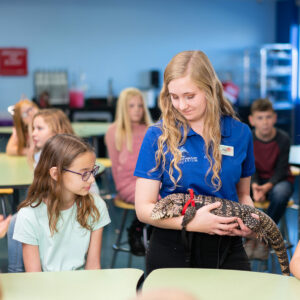EcoVenture Classes are FREE and are an ideal add-on to your Aquarium Field Trip Visit
EcoVenture classes are interactive and align with Next Generation Science Standards and Utah State Core Curriculum guidelines by grade level and/or subject (as with high school.) All classes may or may not include a live animal encounter specifically tailored to the class theme.
EcoVenture classes are 30 minutes in length and begin every 45 minutes.
A link to request an EcoVenture class can be found in the confirmation email you receive after booking your visit.
Last day for EcoVenture classes will be May 26th, 2024. We will resume EcoVenture classes again on August 28th.

Shapes & Colors
Students will develop observation skills by identifying the similarities and differences among shapes, colors, patterns, and numbers associated with animals. They will also develop empathy for living things.
Curriculum Standard: Pre-K/K Math and ELA standards
Nature’s Newborns
Students will discover how young animals are different from their parents and how some animals care for their young. This class will also explore ways in which humans can respect animals in the wild, especially young.
Curriculum Standard: SEEd standard 1.2.3, 1.2.4
Awesome Ocean Creatures
Students will investigate a variety of ocean habitats and the creatures that live there. They will learn that animal behaviors and body structures often determine the type of habitat that is best for survival. Students will be introduced to the dangers of pollution, namely plastic, in the ocean.
Curriculum Standard: SEEd standards 2.2.1, 2.2.2
Incredible Insects
Students will learn about how to identify insects and how they are important to their environment. They will also discover how to recognize changes in our environment and learn simple solutions to help make a positive change to our ecosystems.
Curriculum Standard: SEEd standards 3.2.6
Prehistoric Puzzles
Students will study fossils to find out how animals were able to survive in prehistoric environments and how their descendants have changed over time. They will learn how to identify ancient remains of prehistoric animals to appreciate our planet’s past and future.
Curriculum Standard: SEEd standards 4.1.3
Go with the Flow
We are all connected. Students will uncover the movement of matter through food chains during this program and recognize that all organisms, in life and in death, have an important role to play.
Curriculum Standard: SEEd standard 5.3.2
Current Events
Our oceans provide the flow of life on Earth. Students will explore the process of ocean currents through various experiments to see how the ocean affects our planet and how humans affect our oceans.
Curriculum Standard: SEEd standards 6.3.3
Hives & Harvest
Students will examine the life of bees and assess how altering the living and nonliving components of an ecosystem through human action can lead to fluctuations in populations, for better and for worse.
Curriculum Standard: SEEd standards 6.4.1, 6.4.4
Courtship Color
Birds show off a rainbow of colors, and students will discover how birds get their colors and why colors enable birds to survive and pass on their genes. Students will also learn how humans can help monitor and protect birds in Utah and the world.
Curriculum Standard: SEEd standard 7.4.2
Keep it Light
Energy, like water, flows as a cycle on Earth. This class highlights the role of photosynthesis in food chains. Students will examine the role of photosynthetic microorganisms being cultured at LLPA and appreciate that all life on our planet begins with light.
Curriculum Standard: SEEd standard 8.3.1
In the Field
Extinction is a natural part of life, and students will learn how humans have influenced recent animal extinctions. They will also explore how scientists monitor animal populations to slow or prevent their decline.
Curriculum Standard: SEEd standards BIO 1.4
Sea Turtle Rescue
Students will discover how scientists are able to help injured sea turtles by simulating a sea turtle hospital. They will learn about sea turtle anatomy, how sea turtles can show that they are injured, and what humans can do to help rehabilitate them and prevent further injuries.
Curriculum Standard: SEEd standard BIO 2.6, 2.7

